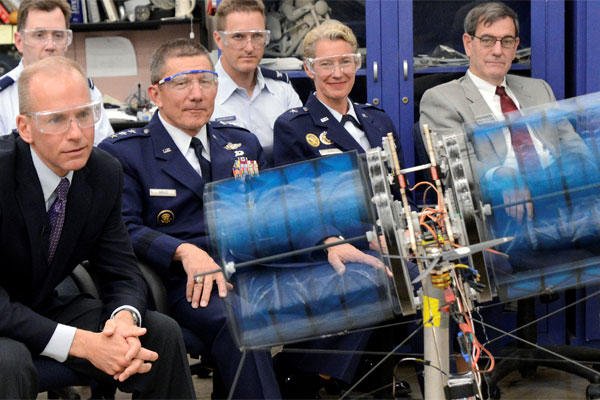U.S. AIR FORCE ACADEMY, Colo. -- Aeronautical Engineering cadets have presented their award-winning design of a search and rescue and medical evacuation aircraft for the year 2045 to Academy and industry leaders at the Aero Lab here May 13.
Nine cadets collaboratively designed "The Night Owl," a futuristic cyclogyro that can direct thrust in any direction, allowing for a hover, forward or backward flight.
The team spent a year on the capstone project and took first place May 9 in a Boeing competition against the U.S. Military Academy and U.S. Naval Academy.
"This is a very impressive piece of work," said Dennis Muilenburg, the executive vice president of Boeing. "This competition gets tougher every year and you guys knocked it out of the park. Your abilities to take ideas, put them into a design and build a working prototype is what differentiated the Academy in the competition. Congratulations, this is clearly sophisticated work."
Cadet 1st Class Zachary Adams, the chief engineer of the team, said the requirements set forth by Boeing included that the aircraft must have an operational radius of 100 nautical miles and would be able to complete its mission in an hour.
"This was the toughest part of the requirements, since the aircraft had to be vertical takeoff and landing capable," Adams said. "Speed was crucial to our design since seconds matter when someone's life is on the line, and it turns out a cyclogyro design is VTOL-capable and can more than double the speeds of current helicopters."
The team also showed attendees a voice control demonstration they designed for aeromedical evacuation and search-and-rescue crew members.
"One of the biggest complaints from the (aeromedical evacuation) and SAR personnel is they can't touch screens because they've got gloves on, blood all over the hands, and they have to be sanitary for the patients," said Cadet 1st Class Patrick Waters, who helped with communications and navigation for the project. "What we decided to go for was voice control; a lot of programs already use a similar voice control. While the technician is working they would say something like 'blood pressure,' and then it would recognize what's happening."
John Pletcher, an instructor in the Academy's Aeronautics Department who helped mentor the team, said cadets were excited about working on a real world project rather than simply an academic exercise.
"Boeing provided $50,000 in gift funds for the project, which not only paid for the supplies and materials to build two cyclorotors, but also allowed the cadets to travel to meet with Air Force experts in various disciplines to determine Air Force needs, as well as new technology that is being developed in the Air Force Research Labs," Pletcher said.
Adams said the cadets on the team have never been so invested in a project.
"I remember nights where we worked for hours straight," he said. "Working on this project has been an incredibly valuable opportunity. I really felt I got a peek into how the engineering world operates, and I had an opportunity to learn from my peers more than I ever had before."
Adams said the project has been a pioneering effort for everyone on the team.
"Not many universities or organizations are conducting research on cyclogyros, and by investing so much in a new concept, our team has set out to accomplish cyclogyro 'firsts,' or in other words achieve something that has never been done before," he said. "It certainly lends credibility to the Academy's undergraduate research programs and simply merits bragging rights."
Cadet 1st Class Lillian Pryor, program manager of the team, said the team hopes that flying this unique aircraft will inspire future cadets to attempt the impossible.
"It gave us the opportunity to apply everything we learned as aeronautical, systems engineering aeronautical, mechanical, and systems engineering management majors," Pryor said. "We're very excited that we're able to show the cyclogyro's potential and are attempting to achieve forward flight with our model, which would be the first recorded controlled forward flight of a cyclogyro."
Adams said he was enthused to be able to brief an audience of such high esteem.
"Everyone on the team was excited to talk about what we've accomplished, and the fact our work attracted the interest of General Gould, General Born, and General Lorenz was really quite amazing," he said.
The seniors involved in the project are Lillian Pryor, Zach Francis, Wolf Thielmann, Jordan Potterton, Luke Hantla, Kristin Long, Patrick Waters, Trey Cottingham and Zach Adams.



























